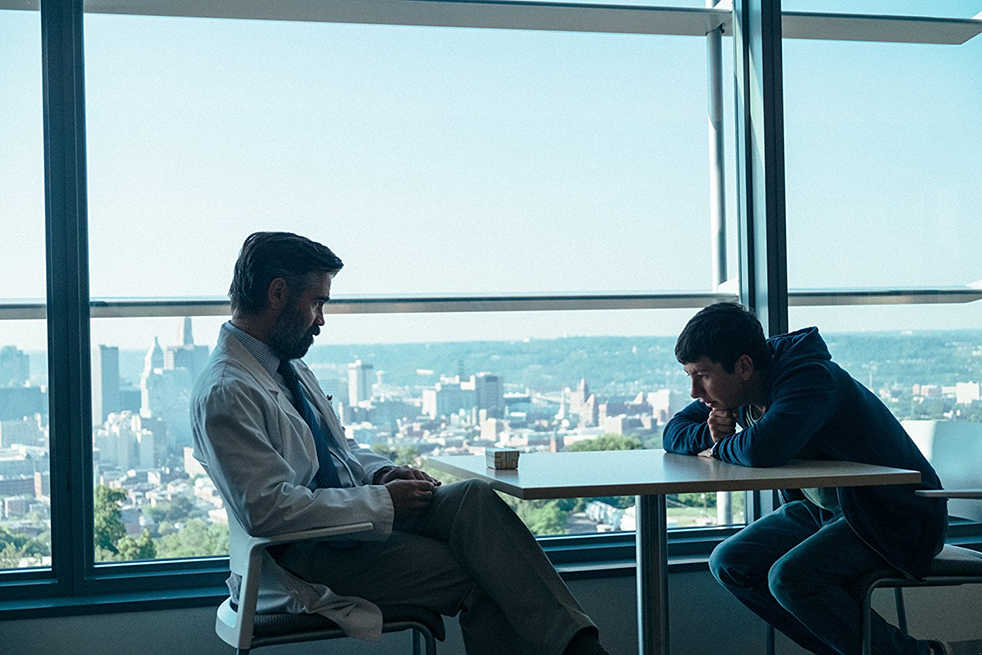Yorgos Lanthimos’s newest film, “The Killing of a Sacred Deer,” is stressful. The film is
uncomfortable, horrifying and — at its best — profoundly difficult to watch.
The film stars Colin Farrell (“The Lobster”) as Steven, a lauded but stoic cardiac surgeon. Steven is the image of American success. He is wealthy, married to a beautiful wife, played by Nicole Kidman (“Eyes Wide Shut”), and has two clearly bright children.
Lanthimos employs his unique brand of atmospheric filmmaking to depict Steven’s perfect life as deeply unsettling. None of the characters seem natural.
Farrell delivers nearly all his lines in a stilted, robotic monotone, and his family responds in kind. Outbursts of emotion — anger, sadness, anything — are rare and significant in this landscape of grey emotional repression.
Lanthimos slowly immerses viewers in Steven’s clinical world. Over the first 30 minutes or so, viewers see glimpses of Steven’s home life. He proudly executes his role as family patriarch, managing his teenage daughter, Kim (Raffey Cassidy, “Tomorrowland”), and his grade-school son, Bob (Sunny Suljic, “The Unspoken”).
In the bedroom, his wife Anna mimics a patient under general anaesthetic per Steven’s request as they make love. Between these scenes, Steven furtively meets with seemingly dull, equally stilted teenager Martin (Barry Keoghan, “Dunkirk”), whose father Steven had accidentally killed on the operating table some years prior.
From these initial scenes, clearly Steven quietly relishes his authority and importance in society. As the movie opens, viewers are treated immediately to an image of a heart beating in an open chest cavity followed by a shot of Steven peeling off his surgeon’s gloves and disposing of them after the surgery. He wipes his hands clean of the surgery figuratively.
Sometimes purging oneself of one’s actions is not so easy. Before long, Kim and Bob fall ill with a mysterious, undetectable ailment. Martin privately reveals to Steven that Bob, Kim and ultimately Anna will all fall ill and die, unless Steven kills one of them.
In a perverted twist of logic, Martin claims this is justice for his father’s death, and Steven must decide. Lanthimos never establishes how Martin cast his curse or whether it is even real.
The uncertainty, mystery and fear that prey upon Steven, Anna and, consequently, the audience slowly builds the foundation for the psychological stress, which Lanthimos exerts on viewers as Steven struggles to decide what to do as his children are ever-so- slowly dying in front of him.
Technically, this film is masterfully made. Lanthimos leverages his vast skill set as a director to make this film as personally uncomfortable as possible, relinquishing traditional jump scares and gory imagery to exploit audience’s empathy for Steven.
Viewers are forced to simultaneously wrestle with Steven’s ethical dilemma and rationalize his often unethical judgments as he grows more and more desperate.
Lanthimos sets a droning, electronic soundtrack to his stark images. The music is ever present, ever restless, but it crescendos during emotionally climactic moments, blaring into viewers’ ears and crawling under their skin.
Lanthimos captures the hospital where Steven’s children lay with floating, sweeping shots that emphasize the emptiness of this clinical environment. Though many of his shots are long and often quite still, the camera itself is never still. Always zooming in ever so slightly, the camera is as restless as the soundtrack, suggesting that the stillness of the image does not equate to peace in the minds of Lanthimos’s characters. There is no reprieve from the tenseness of this world.
The cast also is suitably unsettling. Farrell’s stoicism makes his emotional outbreaks near the film’s end even more poignant. Nicole Kidman plays off his apparent inhumanity with a vigor and silent aggression that is truly intimidating.
The real standout is Barry Keoghan as Martin. Keoghan is psychotic. Initially playing dumb and seemingly slow in the head, Keoghan infuses Martin with a complete lack of empathy that makes his character truly terrifying. He truly believes in the justice of the punishment he has inflicted on Steven’s family. He intends and portrays no malice or emotion — simply conviction, the most unsettling quality of all.
Ultimately, Lanthimos attempts to criticize the notions of importance, power and responsibility in society by forcing Steven to take perverse responsibility for the authority he exercises over people’s lives — forcing him to keep his gloves on for once.
While his point is compelling, the extreme stress, tension and discomfort that Lanthimos exerts on his viewers does not seem justified by this theme. By the end of the film, the plot pushes Steven into truly terrifying territory.
Viewers are forced to ask themselves if they are watching the results of a relevant, meaningful moral dilemma or if the film has simply reduced itself to a sadistic exploration of an inane “Would you rather?” Either way, if viewers are seeking horror, horror they will get. Horror does not get better than this, but some movies do.
